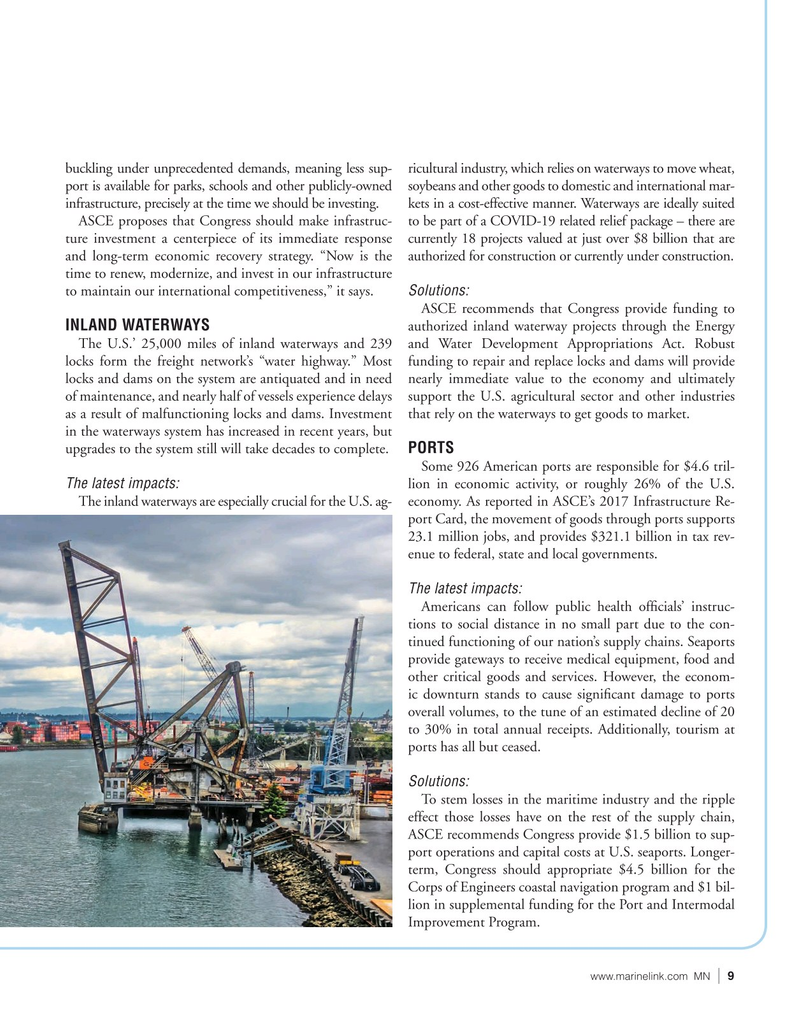
Page 9: of Marine News Magazine (January 2021)
Passenger Vessels
Read this page in Pdf, Flash or Html5 edition of January 2021 Marine News Magazine
buckling under unprecedented demands, meaning less sup- ricultural industry, which relies on waterways to move wheat, port is available for parks, schools and other publicly-owned soybeans and other goods to domestic and international mar- infrastructure, precisely at the time we should be investing. kets in a cost-effective manner. Waterways are ideally suited
ASCE proposes that Congress should make infrastruc- to be part of a COVID-19 related relief package – there are ture investment a centerpiece of its immediate response currently 18 projects valued at just over $8 billion that are and long-term economic recovery strategy. “Now is the authorized for construction or currently under construction.
time to renew, modernize, and invest in our infrastructure to maintain our international competitiveness,” it says. Solutions:
ASCE recommends that Congress provide funding to
INLAND WATERWAYS authorized inland waterway projects through the Energy
The U.S.’ 25,000 miles of inland waterways and 239 and Water Development Appropriations Act. Robust locks form the freight network’s “water highway.” Most funding to repair and replace locks and dams will provide locks and dams on the system are antiquated and in need nearly immediate value to the economy and ultimately of maintenance, and nearly half of vessels experience delays support the U.S. agricultural sector and other industries as a result of malfunctioning locks and dams. Investment that rely on the waterways to get goods to market.
in the waterways system has increased in recent years, but
PORTS upgrades to the system still will take decades to complete.
Some 926 American ports are responsible for $4.6 tril-
The latest impacts: lion in economic activity, or roughly 26% of the U.S.
The inland waterways are especially crucial for the U.S. ag- economy. As reported in ASCE’s 2017 Infrastructure Re- port Card, the movement of goods through ports supports 23.1 million jobs, and provides $321.1 billion in tax rev- enue to federal, state and local governments.
The latest impacts:
Americans can follow public health of? cials’ instruc- tions to social distance in no small part due to the con- tinued functioning of our nation’s supply chains. Seaports provide gateways to receive medical equipment, food and other critical goods and services. However, the econom- ic downturn stands to cause signi? cant damage to ports overall volumes, to the tune of an estimated decline of 20 to 30% in total annual receipts. Additionally, tourism at ports has all but ceased.
Solutions:
To stem losses in the maritime industry and the ripple effect those losses have on the rest of the supply chain,
ASCE recommends Congress provide $1.5 billion to sup- port operations and capital costs at U.S. seaports. Longer- term, Congress should appropriate $4.5 billion for the
Corps of Engineers coastal navigation program and $1 bil- lion in supplemental funding for the Port and Intermodal
Improvement Program.
www.marinelink.com MN 9|

 8
8

 10
10
